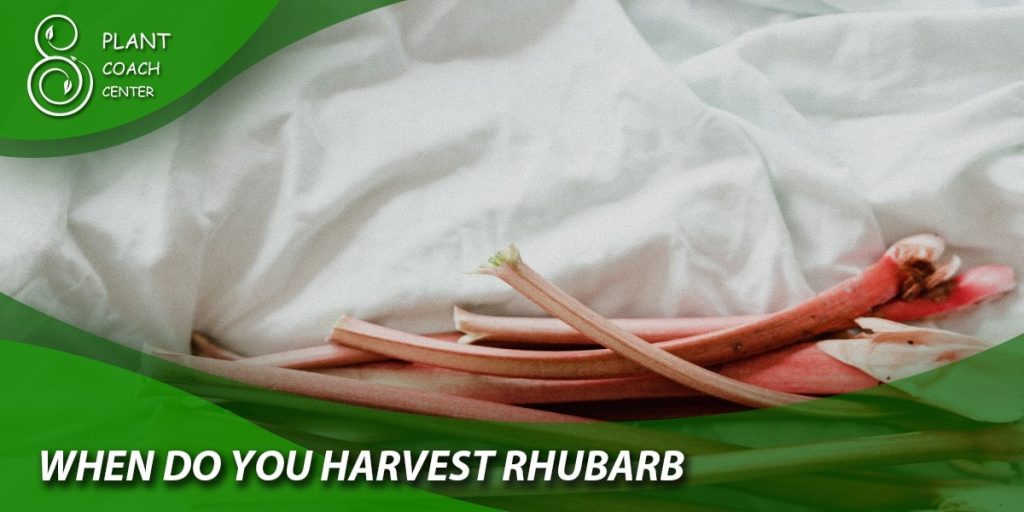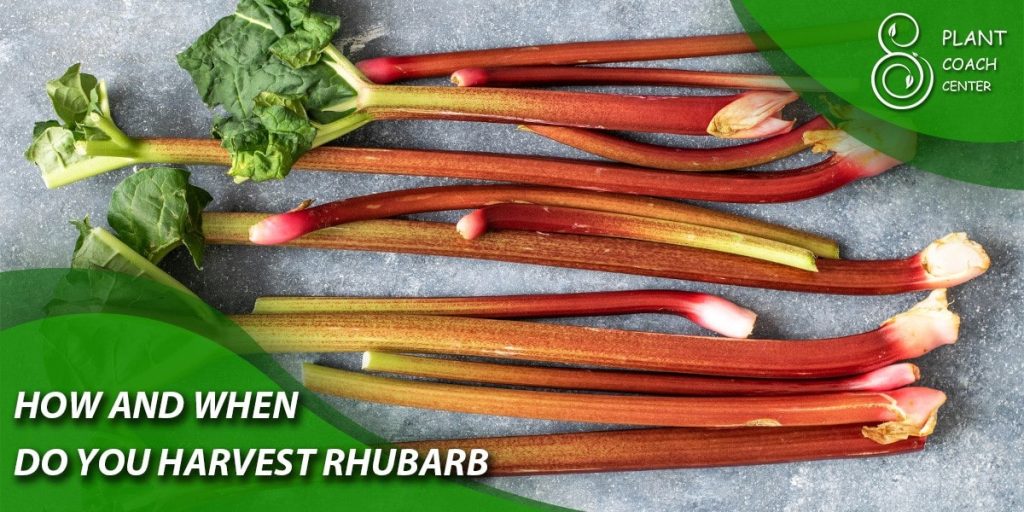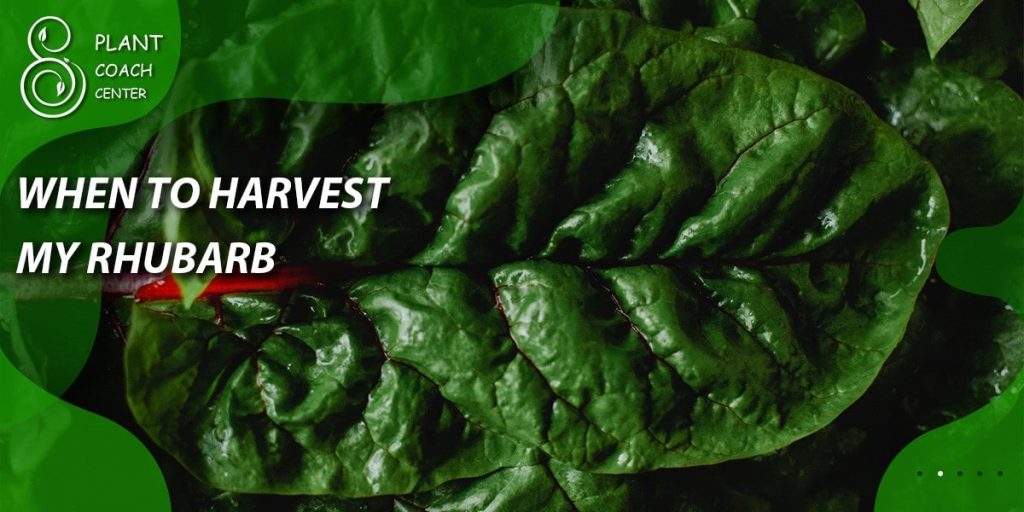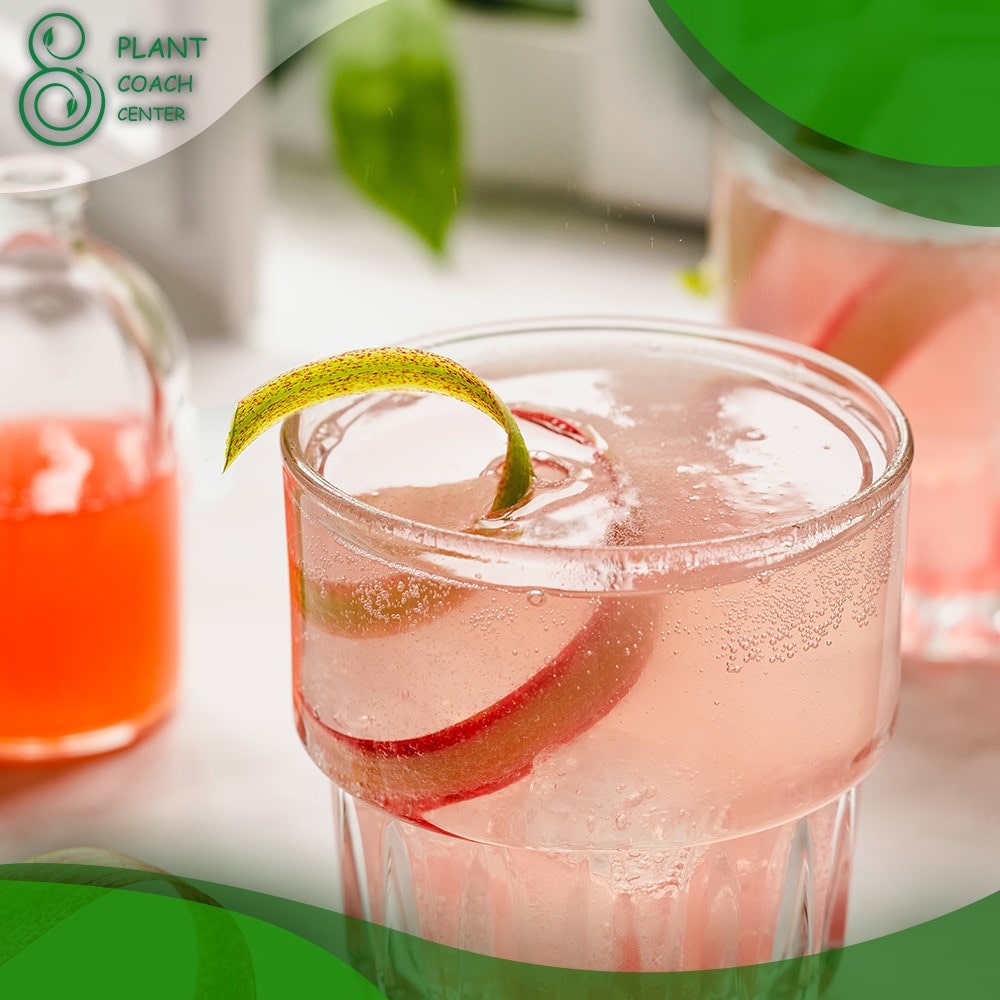When Do You Harvest Rhubarb
As the days grow longer and the warmth of spring unfurls, gardeners and food enthusiasts eagerly anticipate the bountiful harvest season. Amidst the kaleidoscope of vibrant produce, rhubarb stands as a distinctive and beloved plant, celebrated for its tart yet tantalizing flavors.

Whether gracing the center of a luscious pie or lending its unique tang to a savory sauce, rhubarb’s culinary versatility has made it a cherished addition to kitchens worldwide. However, the secret to unlocking the full potential of this perennial lies in perfecting the art of timing its harvest. Understanding when and how to harvest rhubarb is an essential skill that can significantly influence the quality of your yield and, in turn, the delectable creations it will inspire.
In this article, we explore the nuances behind rhubarb harvesting, from the optimal time to pick those ruby-red stalks to the careful preparation and preservation that ensures a year-round supply of this delightful vegetable. Join us as we unveil the secrets to a successful rhubarb harvest and elevate your culinary endeavors.
The Rhubarb Race: Timing Matters!
Imagine your garden as a grand racetrack, with rows of rhubarb plants eagerly waiting to sprint towards their peak ripeness. Like skilled race car drivers, gardeners must gauge the optimal timing to harvest these crimson stalks, as the difference in a few days can drastically impact the taste and texture of the yield. Timing is everything in the rhubarb race!
The starting line for the rhubarb harvest coincides with the arrival of spring. As the soil begins to warm and the first green shoots emerge from the ground, it’s a sign that the rhubarb plants are ready to kick into gear. But hold your excitement! While those tender stalks may be tempting, patience is essential.
It’s recommended to resist the urge to pick any rhubarb during the first year of planting, allowing the plants to establish themselves and develop robust root systems. This sacrifice will pay dividends in the long run, as well-established rhubarb plants yield heartier and more plentiful stalks.
Once the second year arrives, the rhubarb plants are raring to go. The ideal time to begin harvesting is typically in mid to late spring when the stalks reach a desirable thickness of about one inch in diameter. Timing can vary depending on your location and climate, but a good rule of thumb is to wait until about 8 to 10 weeks after the first shoots appear. However, be mindful not to let the rhubarb race too far ahead; harvesting stalks that are too mature can result in toughness and stringiness, diminishing the delectable qualities for which rhubarb is known.
Now, here’s where the real strategy comes into play. Aim to harvest only about one-third of the total stalks from each plant at any given time. Doing so allows the remaining stalks to continue their growth and replenish the plant’s energy reserves, ensuring a sustained harvest throughout the season. Additionally, refrain from harvesting rhubarb too late into the summer, as the plant requires ample time to rebuild its strength before winter.
Chasing the Sun: Understanding Rhubarb’s Growing Season
Just like sunseekers bask in the warmth of summer rays, rhubarb plants are no strangers to the allure of sunlight. As the emerald shoots emerge from the ground, they embark on a journey to chase the sun, absorbing its energy and converting it into the vibrant red stalks we all love. Understanding the relationship between rhubarb and sunlight is crucial to unlocking your harvest’s full potential and cultivating a thriving crop.
Rhubarb, scientifically known as Rheum rhabarbarum, is a hardy perennial that flourishes in cooler climates, especially in regions with distinct seasons. When the first signs of spring arrive, the rhubarb plants awaken from their winter slumber, harnessing the increasingly longer days and the intensifying sunlight.
As they stretch towards the sky, their broad leaves capture the sunlight, converted into sugars through photosynthesis. These sugars are then transported down to the stalks, causing them to grow and develop their signature tartness.
As gardeners, providing the rhubarb plants with the optimum amount of sunlight they crave is essential. Ideally, rhubarb should be planted in a location that receives at least six hours of direct sunlight daily. While they can tolerate some shade, insufficient sunlight can result in weak and spindly growth, compromising the overall yield and taste of the stalks. Additionally, a sunny location helps to keep the soil warm, promoting faster growth and earlier shoots in the spring.
Moreover, understanding the rhythm of the growing season is essential in maximizing the plant’s potential. During the early spring months, when the rhubarb begins its journey, it’s crucial to avoid harvesting any stalks to allow the plant to establish itself fully. The focus should be on nurturing the rhubarb, providing sufficient water and nutrients to support its growth.

The Color Palette of Rhubarb: Picking the Perfect Stalks
In the vibrant world of rhubarb, the color spectrum extends beyond the ordinary green of leaves and stems. The stalks of this unique perennial vegetable paint a rich and diverse palette, ranging from shades of ruby red to pale green and even speckles of pink. Understanding the significance of rhubarb’s color and its connection to readiness for harvest is crucial in selecting the perfect stalks to grace your culinary endeavors.
When identifying ripe and ready-to-pick rhubarb stalks, color plays a starring role. As the plants progress through their growing season, the hues of the stalks evolve, signaling their stage of maturity. As the rhubarb awakens from its winter dormancy early in the spring, the stalks may appear light green or even pale pink. While tempting, it’s best to exercise patience during this stage and let the plant establish itself fully before initiating any harvest.
As the season advances, the color transformation becomes more pronounced. The vibrant red hues emerge as the stalks elongate, and this is where the excitement builds for rhubarb enthusiasts. The deeper and more intense the red color, the more mature and flavorful the branch will likely be. But remember, not all rhubarb varieties develop into the same shade of red, and some may retain a touch of green even when ready for harvest. Thus, observing the overall vibrancy of the color rather than relying solely on uniformity is a more reliable indicator of ripeness.
Beyond the visual appeal, color also serves as a sensory cue to detect the quality of the stalks. Opt for stalks that feel firm and crisp to the touch. A deeper color often suggests that the stalks are packed with anthocyanins, natural antioxidants that contribute to the nutritional value of rhubarb. These compounds provide eye-catching red pigmentation and offer a host of health benefits, making your choice of color an enriching experience for your taste buds and well-being.
When it’s time to harvest, remember to use a sharp knife or scissors to cut the stalks at the base, ensuring a clean and precise cut. Never pull or twist the stalks, as this can damage the plant and reduce future yields.
Patience and Pruning: Preparing Rhubarb for the Harvest
In the world of rhubarb cultivation, patience is indeed a virtue. As this hardy perennial takes root and establishes itself in its designated spot, it’s essential to exercise restraint during its early years to ensure a bountiful and sustainable harvest for years to come. Coupled with prudent pruning practices, preparing rhubarb for the harvest requires a delicate balance of nurturing and selective trimming.
Upon planting rhubarb in your garden, it’s essential to understand that the first year is a critical establishment period. During this time, the focus should be on fostering a robust root system rather than harvesting the tempting stalks.
The plant can channel all its energy into developing solid roots by withholding any harvest in the initial growing season, ensuring a healthier and more productive rhubarb patch in subsequent years. Though it may require some restraint, this patience will be handsomely rewarded when the rhubarb’s true potential is unleashed in future harvests.
As your rhubarb plants enter their second year, it’s an opportune time to embrace the art of pruning. Pruning is a vital practice that encourages the plant to flourish and prevents it from becoming overcrowded. Typically, rhubarb stalks should be ready for harvest in mid to late spring when they reach a desirable thickness of about one inch in diameter. When selecting stalks for harvest, choose the healthiest and most vibrant ones, leaving the smaller, thinner stalks to grow further.
To prune effectively, focus on removing any flower stalks that emerge from the center of the plant. Flowering not only diverts the plant’s energy away from stalk growth but can also lead to a decline in the overall vigor of the rhubarb. By cutting the flower stalks at their base, you redirect the plant’s resources back into the remaining stalks, promoting more substantial growth and a more abundant harvest.
Additionally, periodically thinning the rhubarb patch can have significant benefits. When the plant becomes overcrowded, competition for nutrients can hamper individual stalk growth and reduce the overall yield. Carefully dig up and separate mature rhubarb crowns every few years, leaving ample space for each plant to thrive. Transplanting the divided crowns to new garden areas or sharing them with fellow gardeners is a beautiful way to expand the rhubarb legacy.

A Rhubarb Harvest Feast: Recipes and Ideas
As the days grow longer and the rhubarb stalks reach their peak of perfection, it’s time to indulge in a rhubarb harvest feast that celebrates this vibrant vegetable’s versatility and delectable flavors. From mouthwatering desserts to savory delights, the possibilities for incorporating rhubarb into your culinary creations are endless. Let’s embark on a gastronomic journey and explore some delightful recipes and creative ideas to maximize your rhubarb harvest.
Rhubarb Pie Extravaganza
No rhubarb feast would be complete without the classic rhubarb pie. Combine tart rhubarb with sweet sugar and warm spices like cinnamon and nutmeg, encased in a flaky, buttery crust. Elevate this dessert by adding strawberries or raspberries for a delightful twist or pairing it with a dollop of freshly whipped cream or a scoop of vanilla ice cream.
Rhubarb Chutney
Embrace the savory side of rhubarb with a tangy and aromatic chutney. Simmer chopped rhubarb with onions, ginger, garlic, vinegar, brown sugar, and a hint of chili for a delightful accompaniment to grilled meats or roasted vegetables. This versatile chutney can add flavor to sandwiches, cheese platters, or even as a glaze for tofu or tempeh.
Rhubarb-Infused Beverages
Create refreshing and vibrant beverages by infusing rhubarb into your favorite drinks. Add sliced rhubarb to lemonade or iced tea for a delightful twist, or craft a rhubarb syrup to sweeten cocktails or mocktails. For a truly enchanting experience, infuse rhubarb with herbs like mint or basil for a burst of herbal complexity.
Rhubarb Crisp
For a quick and easy dessert, whip up a rhubarb crisp that showcases the natural flavors of the vegetable. Toss chopped rhubarb with sugar and a touch of lemon juice, and then top it with a crumbly mixture of oats, flour, butter, and brown sugar. Bake until the rhubarb is tender, and the topping is golden brown, and serve it warm with a scoop of ice cream.
Rhubarb Salsa
Give your taste buds a delightful surprise with a zesty rhubarb salsa. Mix diced rhubarb with tomatoes, onions, jalapenos, cilantro, lime juice, and a pinch of salt. This refreshing and tangy salsa pairs perfectly with grilled fish or chicken or as a dip for tortilla chips.
Rhubarb and Goat Cheese Galette
Combine the delightful contrast of sweet and tangy flavors by making a rhubarb and goat cheese galette. Spread goat cheese on a rolled-out pastry dough, arrange sliced rhubarb on top, and fold the edges of the dough over the filling. Bake until the crust is golden and the rhubarb softens, making a sophisticated yet easy-to-make dessert.

Conclusion
In conclusion, the world of rhubarb cultivation is a journey filled with patience, creativity, and culinary delights. Understanding the art of timing the harvest, the significance of sunlight, and the vibrant color cues of readiness are essential for ensuring a successful yield of delectable rhubarb.
Embracing prudent pruning practices and nurturing the young plants during their establishment phase paves the way for a thriving rhubarb patch that continues to bear fruit for years. As the rhubarb feast unfolds, the culinary possibilities are boundless, from classic pies and crisps to innovative savory dishes and delightful beverages.
Moreover, with knowledge of proper storing and preservation methods, the tangy goodness of rhubarb can be savored long after the growing season. So, visit PlantCouchCenter.com to embark on your rhubarb adventure, where you’ll find valuable insights, creative recipes, and the joy of cultivating this versatile and delightful vegetable that has truly earned its place as a beloved addition to the garden and kitchen.
When is the best time to harvest rhubarb?
The ideal time for harvesting rhubarb is mid to late spring when the stalks reach about one inch in diameter.
Can I harvest rhubarb the first year after planting?
It's best to avoid harvesting rhubarb in the first year to allow the plant to establish strong roots for better future yields.
How can I preserve rhubarb for later use?
Rhubarb can be preserved by freezing, canning, making jams, or dehydrating to enjoy its flavors throughout the year.







